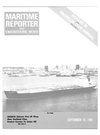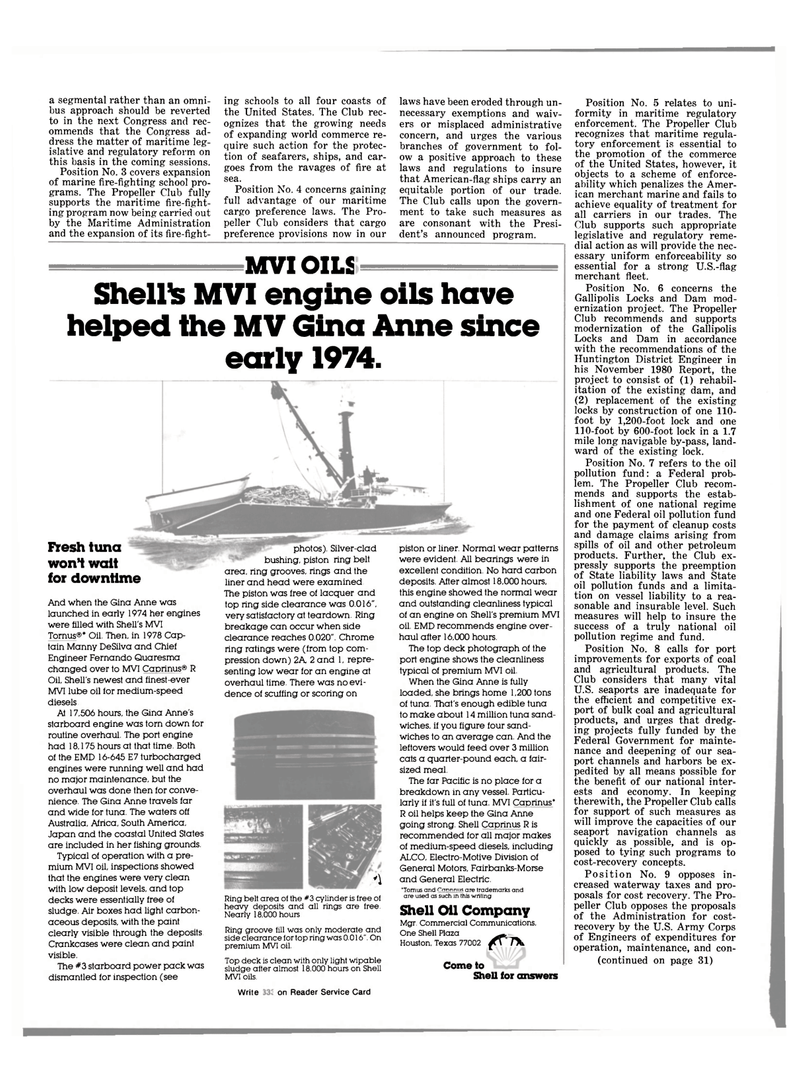
Page 26: of Maritime Reporter Magazine (September 15, 1981)
Read this page in Pdf, Flash or Html5 edition of September 15, 1981 Maritime Reporter Magazine
a segmental rather than an omni- bus approach should be reverted to in the next Congress and rec- ommends that the Congress ad- dress the matter of maritime leg- islative and regulatory reform on this basis in the coming sessions.
Position No. 3 covers expansion of marine fire-fighting school pro- grams. The Propeller Club fully supports the maritime fire-fight- ing program now being carried out by the Maritime Administration and the expansion of its fire-fight- ing schools to all four coasts of the United States. The Club rec- ognizes that the growing needs of expanding world commerce re- quire such action for the protec- tion of seafarers, ships, and car- goes from the ravages of fire at sea.
Position No. 4 concerns gaining full advantage of our maritime cargo preference laws. The Pro- peller Club considers that cargo preference provisions now in our laws have been eroded through un- necessary exemptions and waiv- ers or misplaced administrative concern, and urges the various branches of government to fol- ow a positive approach to these laws and regulations to insure that American-flag ships carry an equitable portion of our trade.
The Club calls upon the govern- ment to take such measures as are consonant with the Presi- dent's announced program.
Position No. 5 relates to uni- formity in maritime regulatory enforcement. The Propeller Club recognizes that maritime regula- tory enforcement is essential to the promotion of the commerce of the United States, however, it objects to a scheme of enforce- ability which penalizes the Amer- ican merchant marine and fails to achieve equality of treatment for all carriers in our trades. The
Club supports such appropriate legislative and regulatory reme- dial action as will provide the nec- essary uniform enforceability so essential for a strong U.S.-flag merchant fleet.
Position No. 6 concerns the
Gallipolis Locks and Dam mod- ernization project. The Propeller
Club recommends and supports modernization of the Gallipolis
Locks and Dam in accordance with the recommendations of the
Huntington District Engineer in his November 1980 Report, the project to consist of (1) rehabil- itation of the existing dam, and (2) replacement of the existing locks by construction of one 110- foot by 1,200-foot lock and one 110-foot by 600-foot lock in a 1.7 mile long navigable by-pass, land- ward of the existing lock.
Position No. 7 refers to the oil pollution fund: a Federal prob- lem. The Propeller Club recom- mends and supports the estab- lishment of one national regime and one Federal oil pollution fund for the payment of cleanup costs and damage claims arising from spills of oil and other petroleum products. Further, the Club ex- pressly supports the preemption of State liability laws and State oil pollution funds and a limita- tion on vessel liability to a rea- sonable and insurable level. Such measures will help to insure the success of a truly national oil pollution regime and fund.
Position No. 8 calls for port improvements for exports of coal and agricultural products. The
Club considers that many vital
U.S. seaports are inadequate for the efficient and competitive ex- port of bulk coal and agricultural products, and urges that dredg- ing projects fully funded by the
Federal Government for mainte- nance and deepening of our sea- port channels and harbors be ex- pedited by all means possible for the benefit of our national inter- ests and economy. In keeping therewith, the Propeller Club calls for support of such measures as will improve the capacities of our seaport navigation channels as quickly as possible, and is op- posed to tying such programs to cost-recovery concepts.
Position No. 9 opposes in- creased waterway taxes and pro- posals for cost recovery. The Pro- peller Club opposes the proposals of the Administration for cost- recovery by the U.S. Army Corps of Engineers of expenditures for operation, maintenance, and con- (continued on page 31)
MVI OILS Shells MVI engine oils have helped the M V Gina Anne since early 1974.
Ftesh tuna wont wait for downtime
And when the Gina Anne was launched in early 1974 her engines were filled with Shell's MVI
Tornus®' Oil. Then, in 1978 Cap- tain Manny DeSilva and Chief
Engineer Fernando Quaresma changed over to MVI Caprinus® R
Oil, Shell's newest and finest-ever
MVI lube oil lor medium-speed diesels
Ai 17,506 hours, the Gina Anne's starboard engine was torn down for routine overhaul. The port engine had 18,175 hours at that time. Both of the EMD 16-645 E7 turbocharged engines were running well and had no major maintenance, but the overhaul was done then for conve- nience The Gina Anne travels far and wide for tuna. The waters off
Australia, Africa, South America,
Japan and the coastal United States are included in her fishing grounds.
Typical of operation with a pre- mium MVI oil, inspections showed that the engines were very clean with low deposit levels, and top decks were essentially free of sludge. Air boxes had light carbon- aceous deposits, with the paint clearly visible through the deposits
Crankcases were clean and paint visible.
The #3 starboard power pack was dismantled for inspection (see photos). Silver-clad bushing, piston ring belt area, ring grooves, rings and the liner and head were examined
The piston was free of lacquer and top ring side clearance was 0.016". very satisfactory at teardown. Ring breakage can occur when side clearance reaches 0.020". Chrome ring ratings were (from top com- pression down) 2A 2 and 1, repre- senting low wear for an engine at overhaul time. There was no evi- dence of sculfing or scoring on <1
Ring belt area of the #3 cylinder is free of heavy deposits and all rings are free.
Nearly 18,000 hours
Ring groove fill was only moderate and side clearance for top ring was 0.016". On premium MVI oil.
Top deck is clean with only light wipable sludge after almost 18,000 hours on Shell
MVI oils. piston or liner. Normal wear patterns were evident. All bearings were in excellent condition. No hard carbon deposits. After almost 18,000 hours, this engine showed the normal wear and outstanding cleanliness typical of an engine on Shell's premium MVI oil. EMD recommends engine over- haul after 16,000 hours.
The top deck photograph of the port engine shows the cleanliness typical of premium MVI oil.
When the Gina Anne is fully loaded, she brings home 1,200 tons of tuna That's enough edible tuna to make about 14 million tuna sand- wiches, if you figure four sand- wiches to an average can. And the leftovers would feed over 3 million cats a quarter-pound each, a fair- sized meal.
The far Pacific is no place for a breakdown in any vessel. Particu- larly if it's full of tuna. MVI Caprinus'
R oil helps keep the Gina Anne going strong. Shell Caprinus R is recommended for all major makes of medium-speed diesels, including
ALCO, Electro-Motive Division of
General Motors, Fairbanks-Morse and General Electric. 'Tomus and Capnnus are trademarks and are used as such in this writing
Shell Oil Company
Mgr. Commercial Communications,
One Shell Plaza .
Houston, Texas 77002 /ft ' i
Come to
Shell for answers 28 Write 142 on Reader Service Card

 25
25

 27
27
